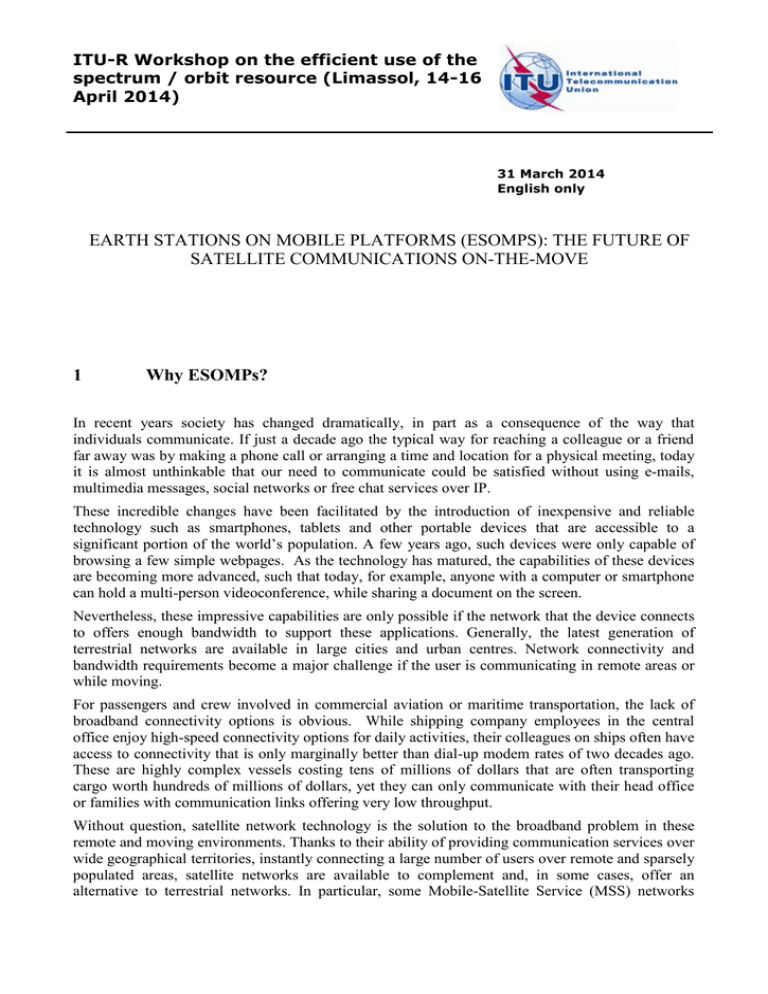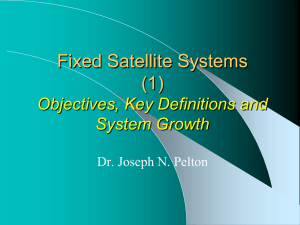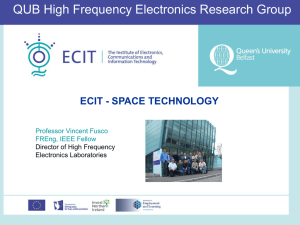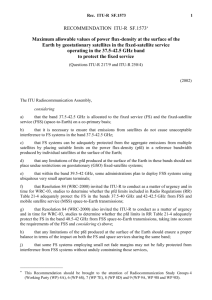1 Why ESOMPs?
advertisement

ITU-R Workshop on the efficient use of the spectrum / orbit resource (Limassol, 14-16 April 2014) 31 March 2014 English only EARTH STATIONS ON MOBILE PLATFORMS (ESOMPS): THE FUTURE OF SATELLITE COMMUNICATIONS ON-THE-MOVE 1 Why ESOMPs? In recent years society has changed dramatically, in part as a consequence of the way that individuals communicate. If just a decade ago the typical way for reaching a colleague or a friend far away was by making a phone call or arranging a time and location for a physical meeting, today it is almost unthinkable that our need to communicate could be satisfied without using e-mails, multimedia messages, social networks or free chat services over IP. These incredible changes have been facilitated by the introduction of inexpensive and reliable technology such as smartphones, tablets and other portable devices that are accessible to a significant portion of the world’s population. A few years ago, such devices were only capable of browsing a few simple webpages. As the technology has matured, the capabilities of these devices are becoming more advanced, such that today, for example, anyone with a computer or smartphone can hold a multi-person videoconference, while sharing a document on the screen. Nevertheless, these impressive capabilities are only possible if the network that the device connects to offers enough bandwidth to support these applications. Generally, the latest generation of terrestrial networks are available in large cities and urban centres. Network connectivity and bandwidth requirements become a major challenge if the user is communicating in remote areas or while moving. For passengers and crew involved in commercial aviation or maritime transportation, the lack of broadband connectivity options is obvious. While shipping company employees in the central office enjoy high-speed connectivity options for daily activities, their colleagues on ships often have access to connectivity that is only marginally better than dial-up modem rates of two decades ago. These are highly complex vessels costing tens of millions of dollars that are often transporting cargo worth hundreds of millions of dollars, yet they can only communicate with their head office or families with communication links offering very low throughput. Without question, satellite network technology is the solution to the broadband problem in these remote and moving environments. Thanks to their ability of providing communication services over wide geographical territories, instantly connecting a large number of users over remote and sparsely populated areas, satellite networks are available to complement and, in some cases, offer an alternative to terrestrial networks. In particular, some Mobile-Satellite Service (MSS) networks -2- offer the possibility of using a single earth station from almost anywhere in the world, but with limitations. Because the amount of spectrum available to the MSS is limited (i.e., usually only a few tens of megahertz) they are not able to meet the data throughput requirements of modern applications that users expect. How can the bandwidth demanded by today’s applications be offered to people in remote areas and on-the-move, then? Today’s GSO Fixed-Satellite Service (FSS) networks provide the answer. In addition to providing the amount of spectrum necessary for high throughput applications, a large part of the overall available FSS spectrum, the Ka-band, is only recently being used by new state-of-the-art satellite networks. These new networks offer significant potential for meeting the communication requirements of users in remote locations, including those in motion. In particular, Earth Stations on Mobile Platforms (‘ESOMPs’), operating with Ka-band GSO FSS networks, represent one way that communications on-the-move will be implemented in the future. The goal of this paper is to describe ESOMPs, focussing not only on a description of their technical design, but also illustrating the regulatory challenges that accompany the introduction of new technologies with the existing international framework. After having identified similarities with other services operating in other bands and potential technical, operational and regulatory issues, a possible solution on how the international community and the ITU-R could implement ESOMPs is presented, which ensures that they provide services needed by current and future generations while still co-existing with other services and technologies sharing the same spectrum resources. 2 ESOMPs: the best of modern satellite network technology Today’s satellites are significantly more advanced than those built and launched just a decade ago. Thanks to major improvements in the technology used in satellite manufacturing, the increased efficiency of solar panels and other components, as well as the enhanced capabilities of launch vehicles to lift much heavier payloads at lower costs, today’s most advanced satellites weigh nearly 4 000 kg and have over 15 kW of power available when in orbit. These advancements, together with better spacecraft antenna technology, allow the focusing of the power flux density on the ground to smaller areas through the use of narrow “spot beams”. Spot beams offer higher G/T ratios for the better reception of signals from the network’s earth stations. These features allow for cheaper and smaller earth stations providing users with an exponential increase in throughput to address the bandwidth requirements of modern applications. Enormous advances have also been made in earth station technology that allow directive antennas to maintain very accurate pointing towards the wanted satellite even when the earth station and the associated satellite move relative to each other. This is possible not only because of advanced and efficient algorithms, through which user terminals’ antennas are able to point and keep the tracking of the wanted satellite, but also because of the fact that such terminals are equipped with multi-axis stabilization capabilities. Through the use of accelerometers and similar technologies, the previously fixed earth stations can detect the movement of the platform on which they are installed as well as the orientation of their antenna towards the wanted satellite. The technology described above goes well beyond the techniques developed for traditional MSS networks that employ low gain antennas installed on aircraft, ships or land vehicles. In the past, these were the only solution available to guarantee a connection between a moving user or platform and a wanted satellite. Unfortunately, the use of low gain antennas means that MSS systems are generally not able to share the same spectrum resources in the same geographical area. These types -3- of omni-directional antennas are not in use with FSS networks operating in the C-, Ku- or Kabands, where satellites serving the same geographical areas and using the same frequency bands are spaced apart by only a few degrees on the GSO arc. The advances in satellite and earth station technology described above make ESOMPs the best solution for users on moving platforms. It brings the benefits of high performance FSS networks to communities that have yet to benefit from true broadband offerings. Nevertheless, in order to ensure the efficient use of the spectrum/orbit resource and because the operation of ESOMPs extends beyond the borders of a particular country or Region, appropriate guidance is needed at the international level to make sure that the benefits of ESOMPs are globally available while ensuring that they operate compatibly with other systems and services sharing the same resources. Section 3 below describes the technical and operational provisions that should apply to the operation of ESOMPs in order to ensure that they do not cause harmful interference to other systems operating in the same frequency bands. Section 4 then focuses on the potential regulatory issues concerning ESOMP operations and proposes a roadmap for addressing these issues in the near term. It should be noted that the discussion hereafter is centred on ESOMPs operating with GSO FSS networks. 3 Technical and operational provisions for ESOMPs As described above, the technology upon which modern satellite networks has been developed, allows for ESOMPs to operate within the technical parameters of an FSS network, even when the earth station is operating on a platform that is moving. The ITU-R has been examining this issue for several years and has adopted ITU-R Report S.2223. The Report contains technical and operational requirements for GSO FSS earth stations on mobile platforms in the bands 17.3 to 30.0 GHz. In addition, Working Party 4A is working toward a Draft New Recommendation for GSO FSS ESOMPs operating in the 29.5-30.0 GHz and 19.7-20.2 GHz bands. The new Recommendation will provide technical requirements for the operation of GSO FSS ESOMPs. It’s important that adequate rules are put in place to ensure that ESOMPs operating with GSO FSS networks can co-exist with other systems and services sharing the same resources. Before addressing this important aspect in more detail, it should be emphasized that ESOMPs are designed to receive transmissions from the same FSS networks that typical fixed earth stations communicate with and require no additional protection as compared to typical FSS earth stations. Therefore, ESOMP operations should not raise any additional concerns in relation to potential interference caused to other systems receiving in the 19.7 - 20.2 GHz band (space-to-Earth). Therefore, no additional measures are necessary because of the introduction of ESOMPs in the ‘downlink’ band of traditional GSO FSS networks. In the ‘uplink’ or Earth-to-space direction, ESOMPs have to comply with the appropriate technical and operational parameters necessary to protect other space services or, if applicable, terrestrial services sharing the same resources. These measures must take into account the fact that ESOMPs can also transmit while in motion. The sections below provide a description of the measures that should be taken to ensure that this new technology is operated without causing harmful interference to existing and future services and systems. -4- 3.1 Protection of other satellite networks Among other precautions that need to be taken into account during the design of ESOMPs is the requirement that they should not cause harmful interference to satellites that are located in the vicinity of the wanted satellite on the GSO arc. As is the case of typical FSS earth stations operating from a fixed location, this can be ensured by ESOMPs complying with adequate off-axis EIRP spectral density limits while operating on moving platforms. That is why, if compared to the limits contained in Recommendation ITU-R S.524-9, the limits currently contained in the Working Document being developed in WP 4A, referenced above are quantitatively the same but specified against a slightly different geometry. The different geometry accounts for the possibility of mispointing due to the movement of the platform upon which the stabilized ESOMP is operating. Annex 1 of this document contains an extract of the Working Document mentioned above related to this issue. Another aspect of the operational and technical Recommendation being developed for ESOMPs in WP 4A would ensure that transmission are required to be towards the correct satellite by employing satellite tracking techniques that are resistant to capturing and tracking by adjacent satellites. Although various techniques are possible to achieve this pointing accuracy, in practice it is usually obtained by the use of an algorithm embedded in the hardware and software of the earth station. The algorithm only permits transmission to the wanted satellite if a pre-determined signal from the wanted satellite is received and recognized by the receiver of earth station. Due to the unique characteristics of the signal received, the ESOMP cannot transmit to an adjacent satellite. Furthermore, another algorithm is usually employed such that the same signal is used as a beacon to adjust the pointing accuracy of the antenna over time. In fact, by requiring the earth station to continuously maximise the power of the signal received from the satellite and adjust its pointing accordingly, it is certain that the ESOMP will only point to the wanted satellite, even when the earth station is operating on a moving platform. The built-in features described above make ESOMPs more accurate at pointing toward the wanted satellite than fixed VSATs in most cases. This is because typical FSS earth stations are not usually equipped with an automatic steering mechanism which could prevent the boresight of the typical FSS earth station antenna from being correctly pointed at the wanted satellite. In fact, fixed VSATs must be set up by a professional installer to ensure that they are correctly pointed; among other initial parameters, and depending on the characteristics of the VSAT terminal, the installer has to optimise its pointing towards the centre of the wanted satellite’s “station keeping box”. This can be challenging because the relative movement between the earth station and the satellite over time has to be taken into account. Furthermore, this manual pointing procedure has to be repeated every time a major weather event, such as a windstorm, happens that could potentially impact the VSAT pointing. Given such limitations on the pointing of fixed VSATs it is clear that ESOMPs, with automatic pointing mechanisms, can achieve as good, if not better, pointing accuracy toward the wanted satellite, than VSATs. Finally, as an additional precaution, ESOMPs are required to immediately reduce or cease transmissions if any mispointing would result in exceeding the eirp spectral density levels mentioned above. Compliance with these provisions is guaranteed by requiring ESOMPs to operate under the constant monitoring and control of a Network Control and Monitoring Center (NCMC) which has the capability of inhibiting ESOMPs from transmitting if it is determined to be causing harmful interference. -5- If all of the above described provisions are complied with, ESOMPs should be considered as equivalent to typical FSS earth stations from an interference perspective. 3.2 Protection of terrestrial networks In theory, FSS earth stations and FS stations can share the same spectrum resources while operating in the same geographical areas, if properly coordinated. Nevertheless, due to the complexity of the potential sharing issues, many regulators prefer to allocate separate spectrum for each service. In some scenarios, ESOMPs might have to share the same spectral resources with terrestrial services operating in neighbouring countries. This issue is not new to the international community, as it has already led to the development of various ITU-R Recommendations1 which attempt to define procedures administrations are invited to follow in the situation where cross-border coordination is required. Nevertheless, the potential interference from ESOMPs into FS receivers deployed in the same areas is known and can be predicted and controlled very precisely by the ESOMP operator. In fact, the level of interference depends primarily on the location of the ESOMP, and the longitude of the satellite on the GSO arc. It also depends on the radiation pattern of the antenna and the power injected at the antenna flange. Since these elements are known to the ESOMP operator for each of the earth stations operating in its network, special measures can then be taken to make sure that no harmful interference is caused to terrestrial services. The CEPT studied the issue of ESOMP sharing the same spectrum with FS stations on a primary basis and published a Report and a Decision2 that takes into account parameters of typical FS systems operating in the Ka-band, including specific pfd thresholds that are set for maritime and aeronautical ESOMP terminals operating in international waters and airspace. If ESOMPs are compliant with those thresholds, they can operate without causing interference to FS receivers deployed in neighbouring territories, without prior agreement with the concerned administrations. Nevertheless, some administrations may not want to use generic pfd thresholds. In these situations, bi-lateral coordination between the ESOMPs operator and the FS station operators and their administration is possible and specific technical and operational provisions can be established on an ad-hoc basis to address the specific network requirements. 4 Regulatory provisions for ESOMPs Allowing mobility in FSS bands might seem, at first, to contradict the principles of the Radio Regulations. Nevertheless, this is not new to regulators or the ITU, as previous examples exist where mobile earth stations have been authorized to use frequency bands allocated to the FSS, subject to certain appropriate technical and operational provisions. ____________________ 1 See Recommendations ITU-R SF.1707 and SF.1719. 2 See ECC Report 184 and ECC/DEC/(13)01. -6- The aim of this section is to focus on past, present and possible future regulatory approaches for GSO ESOMPs to operate in Ka- frequency bands allocated to the FSS, co-existing with systems sharing the same spectrum resources. 4.1 Regulatory approaches in the C- and Ku- bands As previously explained above, the concept of earth stations on moving platforms operating in FSS networks is not new to the international community. In fact, WRC-03 adopted technical, operational and regulatory provisions for Earth Stations on-board Vessels (ESVs) to allow these systems to operate in FSS networks in the C- and Ku-bands. Following the work carried out by WP 4-9S during the study period prior to that WRC-03, the footnote No. 5.457A was added to Article 5 of the RR, which reads as follows: “5.457A In the bands 5 925-6 425 MHz and 14.0-14.5 GHz, earth stations located on board vessels may communicate with space stations of the fixed-satellite service. Such use shall be in accordance with Resolution 902 (WRC-03)” WRC-03 adopted Resolution 902 which includes technical and operational guidelines for ESVs. These provisions are designed to ensure that ESVs do not cause harmful interference to other systems in the FSS and the FS that share the same frequency bands. To protect other FSS networks, ESVs are required to comply with off-axis eirp spectral density limits that are in line with those included in Recommendation ITU-R S.524. Furthermore, ESVs are also required to have a minimum antenna diameter (to limit the number of ESVs deployed) and to respect a minimum distance from the shore of any neighbouring country, without prior agreement with the concerned administrations. The ITU-R also adopted Recommendation ITU-R M.1643 which contains similar provisions for the Aeronautical Mobile Satellite Services (AMSS) operating in the FSS in the 14.0 - 14.5 GHz band. Similar to the situation for ESVs, Recommendation M.1643 specifies provisions for protecting other services. In order to make sure that other FSS networks are not victims of harmful interference caused by Aircraft Earth Stations (AES), AESs not permitted to cause interference greater than that caused by specific and/or typical earth station(s) operating with FSS networks whose characteristics have been published and coordinated with the relevant administrations under the relevant provisions of the Radio Regulations. As far as protection of FS systems on the ground is concerned, the emissions from those AES are required to produce a pfd at the surface of the Earth not exceeding a specified mask. Furthermore, WRC-03 adopted footnote No. 5.504A, which makes clear that AES operating in the AMSS can communicate with space stations operating in another service. The provision reads as follows: “5.504A In the band 14-14.5 GHz, aircraft earth stations in the secondary aeronautical mobile-satellite service may also communicate with space stations in the fixed-satellite service. The provisions of Nos. 5.29, 5.30 and 5.31 apply. (WRC-03)” 4.2 Current regulatory regime in the Ka-band -7- The concept of permitting earth stations to be used on moving platforms in the 29.5 - 30.0 GHz band, depending on the ITU-R Region, is addressed in the Radio Regulations. Footnote No. 5.526 (adopted at the WARC-92) states that: “5.526 In the bands 19.7-20.2 GHz and 29.5-30 GHz in Region 2, and in the bands 20.1-20.2 GHz and 29.9-30 GHz in Regions 1 and 3, networks which are both in the fixedsatellite service and in the mobile-satellite service may include links between earth stations at specified or unspecified points or while in motion, through one or more satellites for point-topoint and point-to-multipoint communications.” Administrations wishing to operate in accordance with No. 5.526 include in their ITU Appendix 4 filings the “UC” class of station that is used for requesting coordination under RR No. 9.7 and notification under RR No. 11 of earth stations while in motion associated with a space station in the FSS in the bands listed under provisions No. 5.526. Currently the establishment of coordination for such links is based on existing criteria for FSS links in the 19.7 - 20.2 GHz and 29.5 - 30.0 GHz bands, as appropriate3. There is an important difference between the regulatory framework for C- and Ku-bands and the Ka-band for ESOMPs. In the first case, earth stations operating while in motion in the C- and Kubands can operate either under provision RR No. 4.4, as is the case for ESVs, per Resolution 902, or using a secondary allocation, as is the case for AESs transmitting in the 14.0 - 14.5 GHz band. In the Ka-band frequencies covered by RR No. 5.526, that footnote instead permits earth stations on moving platforms to operate with FSS networks with the same rights as typical fixed FSS earth stations, i.e., on a primary basis. Also, it is important to remember that the CEPT adopted a similar approach to the regulatory status characterized by RR No. 5.526 and implemented recently by the BR and that developing a framework that allows ESOMPs to operate as part of FSS networks, or an application of the FSS, will assist the deployment of the broadband services by making this new technology available to people who want it around the world. 4.3 done? The future of GSO ESOMPs in the Ka-band: what else should be A lot of work has been carried out by the ITU and national regulators to build a regulatory framework for the authorization and safe operation of ESOMPs. Nevertheless, there are few more steps needed to complete this process and provide an ITU framework for those administrations seeking a Recommendation. First, the work in ITU-R WP 4A on the Draft New Recommendation for ESOMPs operating in the 29.5-30.0 GHz and 19.7-20.2 GHz bands needs to be finalized. Much progress has recently been made and, while most of the wording of the Recommendation has been agreed, there remains some work to finalize the regulatory status of GSO ESOMPs covered in the Recommendation in light of RR No. 5.526. The BR’s Circular Letter CR/358 provides needed clarifications and should help to conclude that discussion so that the document can move forward within SG 4. In parallel, national regulators have developed domestic regulations and procedures for authorising ESOMPs. ____________________ 3 See BR’s Circular Letter CR/358 -8- Furthermore, a separate consideration should be given to the limitations imposed on ESOMPs by footnote No. 5.526. In fact, such provision doesn’t apply to the whole 29.5 - 30.0 GHz band in all Regions and this might represent a heavy restriction for ESOMPs, as they are designed to provide bandwidth-demanding applications on a global basis. Furthermore, the footnote also requires for the satellite networks to be in both the FSS and MSS. These matters are expected to be further discussed at the ITU. 5 Conclusions Technology represented by ESOMPs is already being deployed around the world bringing the benefits of broadband to passengers and crew on ships and aircraft where it has not be available before. Technology improvements, like fixed earth station antenna stabilization, advanced in the latest decade allow for earth stations operating in FSS networks to operate as if they were stationary from an interference perspective. Furthermore, it should be noted that the main aim of the ITU and national regulators is to develop the most appropriate regulatory framework to allow the latest broadband deployment innovations to be made available throughout the world. In fact, as long as the appropriate technical, operational and regulatory measures are implemented, new technologies should not be constrained due to the challenges of adopting an appropriate regulatory framework. It should also be noted that the Radio Regulations, which were in many cases written many years or decades ago need to evolve to encourage flexible and efficient use of the spectrum resources and to support deployment of advanced services to the world. . A good way of concluding this document is to remind the reader that the preamble to the Radio Regulations contains some useful guidance on how to adapt the RR treaty to innovative new technologies such as ESOMPs. Specifically, the Preamble notes that the goals of the Radio Regulations are: 0.6 to facilitate equitable access to and rational use of the natural resources of the radio-frequency spectrum and the geostationary-satellite orbit; 0.7 to ensure the availability and protection from harmful interference of the frequencies provided for distress and safety purposes; 0.8 to assist in the prevention and resolution of cases of harmful interference between the radio services of different administrations; 0.9 services; to facilitate the efficient and effective operation of all radiocommunication 0.10 to provide for and, where necessary, regulate new applications of radiocommunication technology. By allowing the flexibility for ESOMPs to operate in existing FSS allocations in the Ka-band, the ITU is fulfilling the clear goals of the Radio Regulations by encouraging the deployment of new broadband technologies while ensuring efficient use of spectrum and protection of existing services. -9- ANNEX 1 Reference geometry for ESOMPs compared to that of Recommendation ITU-R S.524-94 FIGURE 1 P d=b Θ=φ c a a) ____________________ 4 The content of this Annex is an extract from Annex 6 to Doc. 4A/468. - 10 - d b P φ Θ c a b) where: a b c d represents the earth station on [mobile/moving] platform; represents the boresight of the antenna; represents the geostationary orbit (GSO); represents the vector from the earth station on [mobile/moving] platform to the wanted satellite; φ represents the angle between the boresight of the antenna and a point P on the GSO arch; ϑ represents the angle between the vector d and point P on the GSO arch; P represents a generic point on the GSO arc which angles ϑ and φ are referred to. Figure 1a illustrates that for an earth station on [mobile/moving] platform perfectly pointed to its wanted satellite, the boresight of the antenna and vector d coincide, and angles ϑ and φ are equal. Figure 1b illustrates the case in which the earth station on [mobile/moving] platform is temporarily mis-pointed away from its wanted satellite. In this case, vector d and the boresight of the antenna lie on two different directions, and angles ϑ would be equal to φ plus the antenna mis-pointing in degrees. Because of potential mispointing, any limit on the e.i.r.p. spectral density is defined with respect to angle ϑ and not to angle φ. _______________






